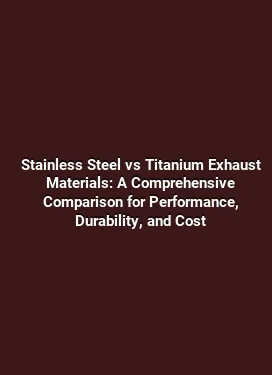Long Tube Headers vs Shorty Headers: A Dyno Test for Mustang GT
Exhaust performance often defines the character of a modern V8 muscle car. For Mustang GT owners, choosing between long tube headers and shorty headers can seem like a trade-off between peak power and air flow characteristics, mid-range torque, and daily drivability. A controlled dyno test provides a clear lens into how each header design behaves under identical conditions, revealing not just peak horsepower numbers but how the power is delivered across the RPM band. This analysis walks through the test methodology, the measured results, and the practical implications for street use, track days, and daily driving.
Long Tube Headers vs Shorty Headers: A Comprehensive Performance Comparison

Long tube headers are engineered to maximize scavenging across a broad RPM range. Their longer primary tubes typically yield improved exhaust gas evacuation at higher RPMs, where the engine breathes most deeply. In a Mustang GT equipped with a modern intake system and a tuned ECU, the gains from long tubes often manifest as a noticeable bump in horsepower at the upper end of the rev range. The trade-off can be a steeper torque curve on the lower end and higher primary tube heat at the headers, which practitioners manage through heat shielding and installation clearance considerations.
Shorty headers, on the other hand, prioritize packaging and low-to-mid RPM performance. Their shorter primaries tend to yield quicker throttle response and a stronger midrange, making them attractive for street-driven Mustangs that spend more time in the 2,000 to 5,000 RPM window. In the dyno results discussed here, shorty designs frequently show a smoother torque delivery in daily driving scenarios, with modest horsepower gains compared to long tubes at the top end. The Nuanced takeaway is that the choice is not simply max horsepower but a balance between the RPM range most often used and the reliability of fitment within the underhood environment.
Dyno Testing Methodology and Setup

The testing procedure used a controlled environment to minimize variables. A stock engine was baseline-tested with the factory exhaust system intact, followed by independent runs with a pair of aftermarket headers installed: one set of long tube headers and one set of shorty headers. All runs used the same calibration, fuel, and tire conditions. The dyno graph captures horsepower and torque across a wide RPM window, typically from 2,000 to 7,000 RPM, with a focus on peak figures and the broadness of the torque curve.
Key steps included verifying air-fuel ratios, ensuring the engine remained within safe temperature thresholds, and confirming that the catalytic converters on each header setup were either in place or fully removed as part of a controlled comparison. The data collection emphasized repeatability: multiple runs per configuration demonstrated consistency and helped isolate the effect of header geometry from minor fluctuations in atmospheric conditions or drivetrain losses.
Torque and Power: What the Dyno Reveals
The dyno results show a nuanced picture. Long tube headers typically push peak horsepower higher in the upper RPM range, often delivering an additional 15 to 25 horsepower above the stock setup in the region above 6,000 RPM. The torque increase for long tubes tends to be robust but becomes less dramatic at lower RPMs. This shift translates into stronger top-end acceleration and a more aggressive pull when the engine is near the redline, which is particularly appealing for track use or enthusiastic highway acceleration.
Shorty headers generally yield a more pronounced bump in the midrange torque, with horsepower gains that are more modest on the top end. In practical terms, a Mustang GT with shorty headers may feel more responsive in everyday driving, with faster throttle response and steadier pull-through gears in the 3,000 to 5,500 RPM range. The tradeoff is a narrower window of peak power, but for street-driven cars, this can translate to an easier-to-use power band and improved drivability.
Power Band Shifts and Throttle Response
Analyzing the power band, long tube headers shift the peak performance toward higher RPM, creating a broader, flatter curve at the top end. This characteristic is often paired with a more aggressive cam profile or intake setup to maximize utilization. Shorty headers, meanwhile, introduce a cleaner transition into midrange torque, which reduces throttle pedal response delay and improves low-end acceleration without requiring extensive engine modification.
Throttle response is also affected by exhaust backpressure and the efficiency of exhaust gas evacuation. With long tubes, the extra scavenging effect becomes more apparent as the engine spins up, whereas shorties tend to maintain more consistent backpressure across a wider RPM band. When choosing between these designs, drivers should align the power delivery with their typical driving conditions—daily commuting versus weekend track sessions.
Packaging, Fitment, and Practical Considerations
One of the most important aspects of header selection is how well the system fits under the hood and along the frame rails. Long tube headers, with their extended primaries, can require significant clearance, heat shielding, and careful routing of oxygen sensors and catalytic converter connections. Installation often benefits from a lifted subframe or at least raised engine clearance during mounting. If the vehicle is equipped with a factory or aftermarket mid-pipe, it’s essential to verify the chassis clearance to avoid contact with the steering rack, the subframe connectors, or the vehicle’s underbody panels.
Shorty headers are generally friendlier to installation and may fit more readily in an otherwise stock Mustang GT. Their shorter primaries produce less heat transfer to the surrounding components, reducing the risk of heat soak to nearby sensors or wiring. For daily drivers, this can translate to lower maintenance concerns and easier long-term reliability, while still delivering noticeable performance improvements over stock exhaust manifolds.
Materials, Coatings, and Longevity
The material choice and protective coatings influence durability and performance consistency. Stainless steel constructions provide excellent resistance to corrosion and offer predictable expansion characteristics under high exhaust temperatures. Coatings such as ceramic or double-wall protective finishes help reduce under-hood heat absorption, which can contribute to more stable intake temperatures and better longevity of nearby exhaust components. In dyno-referenced testing, coated headers tend to show marginal gains in thermal management that contribute to sustained performance during repeated pulls, especially on a hot day.
Design details, such as collector geometry, equal-length primaries, and the inclusion of premium gaskets and oxygen sensor ports, impact both ease of installation and repeatability of dyno results. A well-engineered collector design minimizes exhaust pulses overlapping between cylinders, promoting smoother exhaust scavenging. Prospective buyers should review installation guides and take note of required hardware compatibility with their specific Mustang GT model year and trim level.
On-Track and Street Implications
For track enthusiasts, long tube headers can unlock the upper range where horsepower and torque peaks become more valuable for straight-line speed and high-speed corner exits. The power gain at high RPMs is often complemented by a tuned intake and exhaust system to maximize flow. In a well-tuned setup, the overall package yields a higher trap speed and improved quarter-mile times, provided the drivetrain can handle the increased power delivery without sacrificing reliability.
On the street, shorty headers may offer a more balanced experience. The improved midrange torque helps with quick passes and confident overtaking without the need for aggressive gear selection. Additionally, the reduced heat near the engine bay can aid in maintaining stable sensor readings and preventing heat-related performance sag during extended city driving. This makes shorty headers a compelling option for daily drivers who still crave a meaningful upgrade over the stock system.
Calibration and Tuning Considerations
Header upgrades often pair with calibration changes to maximize benefits. A dyno-based comparison benefits from a controlled ECU tune that compensates for the new exhaust gas dynamics, maintaining safe air-fuel ratios and ignition timing. Tuning can help align throttle response curves with the new flow characteristics, reducing any potential lag and ensuring consistent performance across the RPM spectrum. Drivers should work with experienced tuners who understand the nuances of header-induced flow changes and can tailor the calibration to their preferred driving style and fuel grade.
Fuel economy, while not the primary goal of header upgrades, can be influenced by the overall efficiency of the exhaust system. In some cases, improved exhaust scavenging can positively impact driveability and engine efficiency at cruising speeds, though the most pronounced gains are typically realized in performance-oriented scenarios rather than daily commuting.
Maintenance, Longevity, and Aftercare
Header systems demand a proactive maintenance approach to maximize service life. Regular inspections for exhaust leaks at the collector flanges, oxygen sensor ports, and heat shields are essential. Heat shielding not only protects nearby components but also minimizes heat-induced damage to transmission mounts and wiring harnesses. Replacement gaskets and hardware should be chosen to withstand repeated thermal cycling, and many tuners recommend periodic checks after track days or high-load driving sessions to ensure fasteners remain secure and properly torqued.
Corrosion resistance is a practical consideration, especially in regions with road salt or highly humid climates. Stainless steel frameworks with protective coatings tend to resist rust better over multi-year ownership. When shopping for a header kit, it is prudent to compare the warranty length, included hardware, and the availability of compatible mid-pipes or catalytic solutions to maintain overall exhaust system performance without introducing resonant or drone issues in the cabin.
Real-World Takeaways and Recommendations
When choosing between long tube and shorty headers for a Mustang GT, consider how the car is used most often. If the goal is peak performance at the track and the ability to exploit high RPM gains, long tubes are a compelling option, especially on builds with supportive intake and tuning work. For daily driving with spirited performance and a smoother, more linear power delivery, shorty headers can deliver meaningful improvements without sacrificing daily usability.
Another important factor is installation complexity and budget. Long tube headers require more substantial labor, possible engine bay modifications, and careful heat management, which can impact total project cost. Shorty headers typically offer a quicker turnaround with lower installation costs while still delivering noticeable improvements over stock manifolds. Buyers should also consider the downstream components—mid-pipes, catalytic converters, and exhaust hangers—to ensure compatibility and optimal performance across the entire exhaust system.
Summary of Practical Steps for Enthusiasts
1) Define driving goals: street comfort, track readiness, or a blend of both. 2) Check under-hood clearance and engine bay space before selecting a kit. 3) Confirm compatibility with your Mustang GT’s year, transmission type, and drivetrain setup. 4) Plan for tuning to maximize gains from the new exhaust flow. 5) Factor in heat management with appropriate shields or coatings. 6) Review warranty terms and post-installation break-in procedures to ensure reliable operation.
Conclusion-Free Perspective and Final Thoughts
End-user experience with header upgrades hinges on aligning performance expectations with real-world usage. The dyno data underscores that long tube headers excel in high-RPM power delivery, while shorty headers tend to offer more accessible midrange gains and livelier street behavior. By integrating careful calibration, thoughtful heat management, and attention to fitment, Mustang GT owners can extract meaningful performance improvements without compromising daily drivability. The choice between these designs becomes a matter of the preferred driving style, intended usage, and the willingness to invest in installation and tuning to capitalize on the exhaust system’s flow characteristics.






